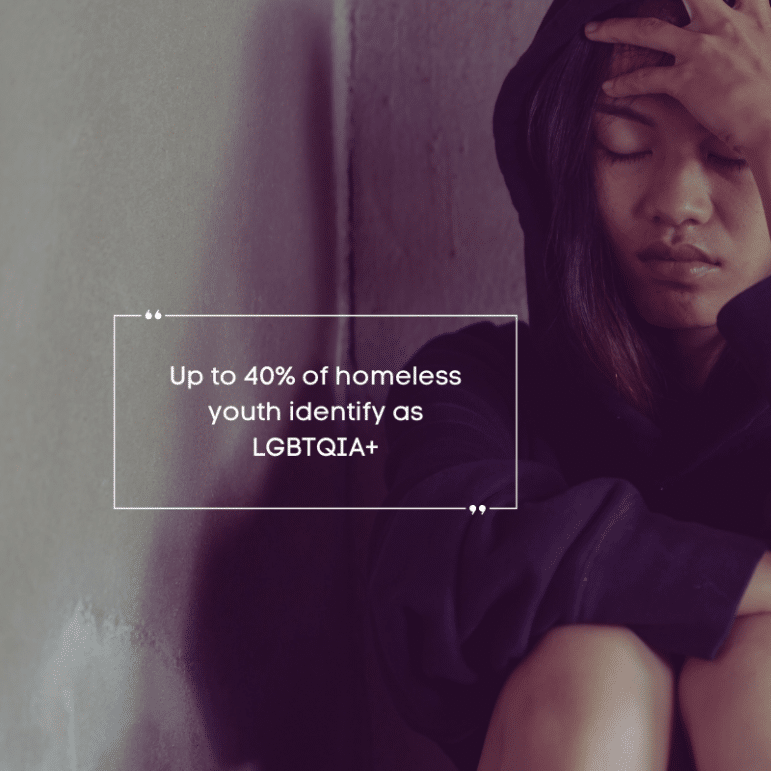Hunger and food insecurity are global issues that affect diverse populations, and the LGBTQIA+ community is no exception. While progress has been made in advancing LGBTQIA+ rights and visibility, this community still faces unique challenges, including higher rates of poverty and food insecurity. In fact, according to an NPR article from 2021, data shows that LGBTQ+ adults are facing hunger at almost twice the rate as others.
Reasons for Disproportionate Hunger and Food Insecurity among the LGBTQIA+ Community
Disproportionate Rates of Poverty
According to a report by the Williams Institute at UCLA Law, LGBTQIA+ individuals are more likely to experience poverty than their cisgender, heterosexual counterparts. This disparity can be attributed to factors such as employment discrimination, wage gaps and limited access to educational opportunities. Poverty acts as a significant driver of food insecurity, making it a crucial issue to address within the LGBTQIA+ community.
Discrimination and Stigma
Discrimination and stigmatization of the LGBTQIA+ community have far-reaching effects, including economic marginalization. Studies have shown that LGBTQIA+ individuals are more likely to face employment discrimination, leading to higher rates of unemployment or underemployment. This financial instability directly contributes to food insecurity, making it challenging for individuals to consistently access nutritious food. As stated by Move for Hunger, “Nondiscrimination laws vary by state, and many have no protections for discrimination in housing, credit, public accommodations, and more.”
Youth Homelessness
Homelessness is a harsh reality faced by many LGBTQIA+ youth who are disproportionately affected by family rejection and lack of support. These circumstances often result in leaving LGBTQIA+ youth at higher risk of becoming unhomed and experiencing food insecurity. According to the National Network for Youth, up to 40% of homeless youth identify as LGBTQIA+. Without a stable living situation, accessing regular meals becomes an ongoing daily struggle.

Mental Health Impact
Food insecurity takes a toll on an individual’s mental health, and the LGBTQIA+ community already faces higher rates of mental health challenges. Studies have shown that LGBTQIA+ individuals are more likely to experience depression, anxiety and suicidal ideation. The added burden of food insecurity exacerbates these issues, creating a cyclical pattern that is difficult to break.
How Can We Help?
1. Raise Awareness
Raising awareness about the intersection of hunger, food insecurity and LGBTQIA+ issues are crucial. Organizations and individuals can support LGBTQIA+ inclusive policies, challenge discriminatory practices and work toward creating safe spaces for all. By advocating for equal opportunities and protections, we can address the root causes of poverty and food insecurity within the LGBTQIA+ community.
2. Support LGBTQIA+ Organizations
Donate to and volunteer with LGBTQIA+ organizations that focus on addressing hunger and food insecurity. These organizations work tirelessly to provide meals, resources and support to vulnerable members of the community. By contributing time, funds or resources, we can help bolster their efforts and make a tangible difference in the lives of those facing food insecurity. For example, the Greater Chicago Food Depository collaborates with organizations looking to provide support to this vulnerable population. They have worked with the Center on Halsted, the Night Ministry, Care for Real and Brave Space Alliance to ensure food insecurity among the LGBTQIA+ community is given the necessary attention that it deserves. The Food Bank for New York City not only accepts donations (where every $1 donated helps provide five meals), but it also has resources to help others fundraise and advocate for New Yorkers who are facing hunger and poverty; including those who identify as part of the LGBTQIA+ community.
3. Promote Economic Empowerment
Support initiatives that promote economic empowerment for the LGBTQIA+ community. This can include job training programs, mentorship opportunities and entrepreneurship support. By addressing the economic disparities and promoting financial stability, we can reduce the prevalence of food insecurity within the LGBTQIA+ community.

4. Foster Inclusive Food Programs
Encourage the creation of inclusive food programs and initiatives that address the unique needs of the LGBTQIA+ community. These programs can include LGBTQIA+ friendly food banks, meal services and collaborations with LGBTQIA+ organizations. By ensuring that these programs are accessible, welcoming and sensitive to the community’s specific needs, we can make a positive impact on food security.
Conclusion
With the increasing cost of goods due to inflation, it is necessary to identify and support communities who are particularly vulnerable to food insecurity. The food security needs of the LGBTQIA+ community should be given serious consideration as economic trends continue to put immense pressure and stress on individuals.
References
LGBTQ Adults are Facing Hunger at Almost Twice the Rate as Others, New Data Shows – NPR
LGBT Poverty in the United States – Williams Institute, School of Law
Hunger in the LGBTQIA+ Community – Move for Hunger
LGBTQ+ Youth Homelessness – National Network for Youth
Why LGBTQ people are more likely to face hunger (and how our partners are helping) – Greater Chicago Food Depository
Food Insecurity in the LGBTQ+ Community – Food Bank for New York City


